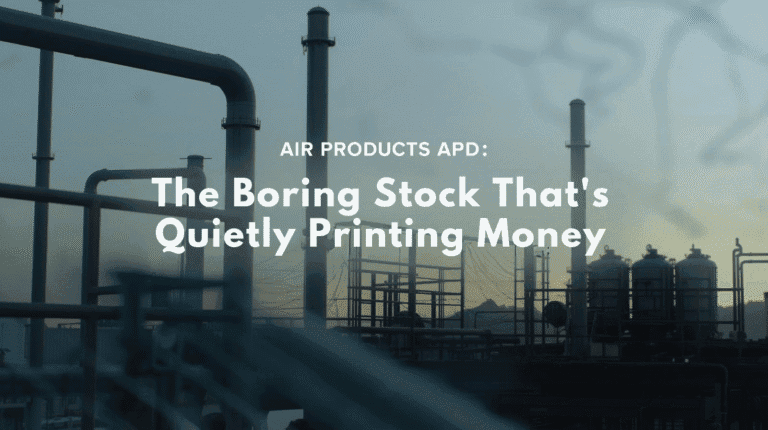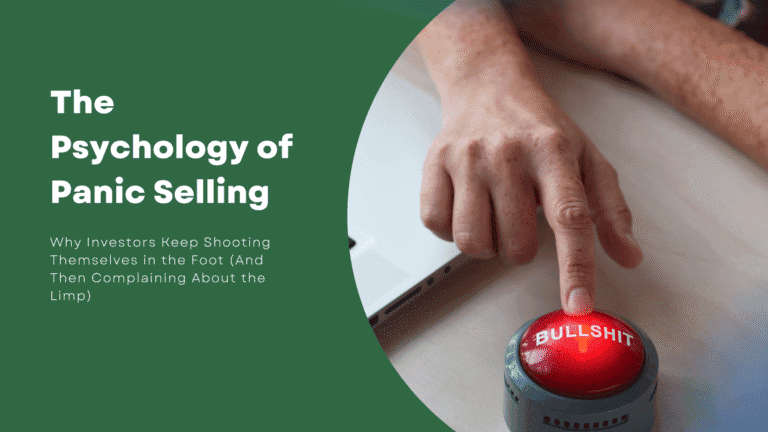The Dividend Delusion: Why 90% of “Income Investors” Still Miss the Point
Dividend Delusion: The Cult of the Cash Drip
Welcome to the Church of the Dividend, where investors gather every quarter to worship the sacred “cash flow.” The ritual is simple: buy a stock that pays a dividend, watch it drop 15%, and still smile because you “got paid.”
Here’s the uncomfortable truth: most income investors are living in a Dividend Delusion. They think collecting dividends makes them rich, when in reality, it’s often the slowest, least tax-efficient, and most misunderstood way to build wealth.
Dividends aren’t a magical stream of money — they’re a corporate payout that subtracts from the company’s value. Yet many retail investors treat them like free money falling from financial heaven. Spoiler: it’s not heaven. It’s accounting.
So let’s expose the Dividend Delusion and rebuild your dividend strategy — not as a religion, but as a science.
The Church of Dividends — and Its Blind Followers
Somewhere along the line, “dividend investing” became less of a strategy and more of a belief system. The Dividend Delusion has captured millions of investors who recite these sacred mantras: Novice investors, in particular, are especially susceptible to these misconceptions, often drawn in by the allure of dividends without fully understanding the risks or mechanics involved.
“Dividends never lie.”
“I don’t care if the stock drops, I still get paid!”
“It’s passive income, bro.”
Cute. But let’s call this what it is — financial virtue signaling and a textbook case of Dividend Delusion.
The reality is that dividends don’t make you rich; compounding does. When investors chase yield instead of performance, they fall victim to the Dividend Delusion — confusing income with intelligence.
Companies don’t pay dividends because they love you. They pay dividends because they can’t find better ways to grow internally. Translation: you’re getting paid because they ran out of ideas. Understanding this is the first step in escaping the Dividend Delusion.
According to research from Morningstar, total return matters far more than yield alone — yet the Dividend Delusion keeps investors focused on the wrong metric.
The High-Yield Trap: When “Income” Means “Implosion”

Yield chasers are the lottery players of the stock market, and they’re the most common victims of Dividend Delusion. They see an 8% yield and think, “That’s guaranteed money.” It’s not. It’s a neon warning sign that says, “Danger — unsustainable payout ahead.”
Take AT&T — the textbook example of Dividend Delusion in action. Investors held it for decades, hypnotized by a 7% yield that looked attractive only because the share price kept falling, making the yield appear artificially high. This declining share price was a warning of underlying problems, and eventually, the dividend got cut. The result? Their total return was worse than inflation, and their “income” couldn’t save them.
The Wall Street Journal has documented countless cases where high-yield stocks underperformed the market — proof that the Dividend Delusion destroys wealth rather than building it.
The math is brutal:
A 7% yield means nothing if the stock drops 20%.
A dividend cut erases years of gains in one announcement.
Reinvested income in a bad company compounds losses, not wealth.
High-yield stocks often mask declining fundamentals, excessive debt, or management desperation. It’s not a bargain — it’s bait designed to trap those suffering from Dividend Delusion.
The Math Most Investors Refuse to Do
Here’s where the Dividend Delusion really shows its ugly face. Most investors don’t calculate total return — the actual performance measure that combines price appreciation and dividends.
They see the dividend check hit their account and assume they’re winning. But in reality, that check might just be returning their own capital in disguise. This is the Dividend Delusion at its most dangerous.
According to Investopedia’s comprehensive guide, total return is the only metric that matters for long-term wealth building — yet the Dividend Delusion keeps investors fixated on quarterly payouts. To properly evaluate investment effectiveness and risk-adjusted returns, investors should also consider key performance metrics such as CAGR, Sharpe ratio, and drawdowns.
Let’s simplify it:
Total Return = Price Appreciation + Dividends – Inflation – Taxes
But investors trapped in the Dividend Delusion focus only on the middle part — the dividend — ignoring whether the company is actually growing.
Example:
Stock A: 8% yield, flat growth, total return 6% after inflation.
Stock B: 2% yield, 10% annual growth — total return 12%.
One gives you “income.” The other builds wealth. Guess which one the YouTube “dividend gurus” recommend? They’re peddling the Dividend Delusion, and millions are buying it.
The Psychology Behind the Dividend Delusion
Behavioral finance 101: people crave predictability. The Dividend Delusion thrives because dividends feel predictable — like a paycheck. It triggers a dopamine hit, a reward cycle that makes you feel like you’re earning money even if your portfolio’s tanking.
Research from Behavioral Economics explains why the Dividend Delusion is so powerful: it exploits our psychological biases and need for immediate gratification.
That illusion of safety is powerful. It’s why retirees love dividends, why influencers sell dividend courses, and why people cling to payouts from dying companies like a financial life raft. The Dividend Delusion feeds on fear and uncertainty. The desire for current income drives many investors to favor dividends, sometimes prioritizing steady cash flow over long-term growth potential.
This is loss aversion mixed with confirmation bias:
“I’m not losing money; I’m getting paid.”
“Dividends prove the company’s strong.”
“If it yields 10%, it must be a good deal.”
This mindset turns smart investors into income junkies — chasing the next payout instead of evaluating fundamentals. Breaking free from Dividend Delusion requires confronting these cognitive biases head-on.
Psychology Today has documented how mental accounting errors contribute to the Dividend Delusion — investors treat dividend income differently than capital gains, even though both are simply returns on investment.
The Right Way to Think About Dividends

Dividends aren’t bad. In fact, they’re an important part of total return — when earned the right way. The problem isn’t dividends; it’s the Dividend Delusion around them. Effective dividend strategies focus on total return and sustainable growth, not just chasing high yields.
🔹 Think Growth First, Income Second
If a company can reinvest its profits at high returns (ROE, ROIC), you want it to keep that cash — not hand it to you. Non dividend paying stocks often reinvest earnings to fuel growth, which can lead to superior long-term returns compared to dividend payers. This principle alone can cure the Dividend Delusion.
Great companies like Apple, Microsoft, and Texas Instruments pay modest dividends because they don’t need to buy your loyalty — they earn it through consistent growth. They’ve escaped the Dividend Delusion trap that snares lesser companies.
The Motley Fool emphasizes that the best dividend stocks prioritize sustainable growth over high yields — the antidote to Dividend Delusion.
🔹 Focus on Dividend Growth, Not Yield
The real strategy is Dividend Growth Investing (DGI) — buying companies that consistently increase payouts because profits are rising, not because the stock price is collapsing. This approach systematically eliminates Dividend Delusion from your investment process.
Look for:
- Payout ratio < 60%
- 5-year dividend CAGR > 5%
- Debt-to-equity < 1.0
- Consistent revenue and free cash flow growth
Portfolios focused on stocks with a lower dividend yield can sometimes be more tax-efficient and deliver higher net returns over time, especially when factoring in dividend taxes and capital gains.
These metrics help you avoid the Dividend Delusion that comes from chasing unsustainable yields.
Simply Safe Dividends provides tools to analyze dividend safety scores — essential for investors wanting to escape Dividend Delusion.
🔹 Understand Total Return Mentality
Reinvesting dividends (DRIP) compounds wealth exponentially over time — but only when the underlying company is solid. Having dividends reinvested can significantly boost long-term investment performance through the power of compounding, maximizing your total returns. Otherwise, you’re just reinvesting in mediocrity while trapped in Dividend Delusion.
Dividend.com offers comprehensive data on dividend aristocrats and dividend growth stocks — companies that have proven they’re worthy of long-term investment and free from Dividend Delusion.
Case Study: The Buffett Blueprint

Warren Buffett doesn’t chase yield — he lets yield come to him. His approach is the perfect antidote to Dividend Delusion.
He bought Coca-Cola in 1988. Back then, the yield was a modest 3%. Today, his yield on cost exceeds 50%. That’s what happens when you focus on quality, not quantity — when you reject Dividend Delusion in favor of sound investing principles.
According to Berkshire Hathaway’s annual letters, Buffett has consistently warned against the Dividend Delusion that causes investors to prioritize immediate income over long-term value creation.
Buffett’s lesson is simple:
“Time + Quality + Patience > Chasing yield.”
That’s not sexy enough for Reddit threads, but it’s how real wealth gets built — and how you permanently escape Dividend Delusion.
The Overlooked Power of Share Repurchases
If dividends are the cash drip that so many investors worship, then share repurchases are the stealthy ninja moves happening in the background—quietly boosting your wealth without the fanfare (or the tax bill). Stock buybacks, as they’re often called, are when a company uses its cash to buy back its own shares from the market. The result? Fewer shares outstanding, higher earnings per share, and often a nice lift in the stock price—all without triggering a taxable event for shareholders.
For dividend investors obsessed with regular income, it’s easy to overlook the power of buybacks. But here’s the kicker: while dividend paying stocks hand you cash (and a tax bill) every quarter, share repurchases let your wealth compound quietly, especially in taxable accounts. No immediate dividend income means no immediate taxes—just the potential for higher capital appreciation and a bigger slice of the company pie.
Why should you care? Because companies that prioritize stock buybacks can deliver value in ways that high dividend yields simply can’t. Instead of locking themselves into ever-higher dividend payments, these companies have the flexibility to return capital when it makes the most sense—often when their shares are undervalued. That’s a win for long-term investors focused on total return, not just quarterly payouts.
Why the Smart Money Buys “Boring”
The Dividend Delusion thrives on excitement — “10% yield!” “Monthly payers!” “Passive income now!”
Meanwhile, the smart money quietly accumulates boring blue chips that have proven immune to Dividend Delusion:
- Johnson & Johnson (JNJ)
- Procter & Gamble (PG)
- PepsiCo (PEP)
- Texas Instruments (TXN)
However, focusing solely on dividend stocks can cause investors to miss out on opportunities in the broad market. Diversifying across the entire broad market, rather than just dividend payers, can lead to better long-term total returns.
Their dividend growth is steady, their businesses predictable, and their capital appreciation consistent. It’s not glamorous, but neither is compounding — until it is.
S&P Global tracks the S&P 500 Dividend Aristocrats — companies that have increased dividends for 25+ consecutive years. These firms have definitively conquered Dividend Delusion through disciplined capital allocation.
Checklist: How to Avoid the Dividend Delusion
| ✅ Do This | 🚫 Not This |
|---|---|
| Focus on total return | Obsess over yield percentage |
| Study payout ratios | Ignore balance sheets |
| Reinvest dividends | Cash them and brag |
| Choose dividend growers | Chase dividend cutters |
| Diversify sectors | Overload on REITs and utilities |
| Use dividend income strategically | Treat dividends as a personality |
| Evaluate the performance and risk of dividend portfolios | Assume all dividend stocks are safe |
Evaluating the performance and risk of dividend portfolios is crucial for avoiding the pitfalls of Dividend Delusion. Not all dividend-paying stocks or portfolios offer the same risk profile or long-term returns, so understanding how your dividend portfolios perform—and what risks they carry—helps you make more informed, resilient investment decisions.
FINRA offers investor education resources to help you make smarter dividend decisions and avoid the pitfalls of Dividend Delusion.
Tax Implications: The Hidden Cost of Dividend Delusion
Here’s something the Dividend Delusion crowd rarely mentions: tax efficiency. Dividends are taxed annually, while unrealized capital gains compound tax-free until you sell. Investors must pay taxes on dividends each year, which creates a tax drag on returns in a taxable account.
According to the IRS guidelines, qualified dividends are taxed at capital gains rates, but you still pay yearly — reducing your compounding power. The Dividend Delusion ignores this mathematical disadvantage.
For high-income earners, the Dividend Delusion becomes even more expensive when you factor in state taxes and potential AMT implications. Dividends increase taxable income for taxable investors, while being able to choose when to realize capital gains gives you more control over the tax impact on your entire portfolio. Growth investing often provides superior after-tax returns — yet another reason to question the Dividend Delusion.
Wrapping Up: Stop Worshipping Yield — Start Worshipping Math
The Dividend Delusion is comforting. It gives investors the illusion of control in a chaotic market. But illusions don’t grow wealth — discipline does.
Dividends aren’t magical checks from the universe. They’re corporate decisions with opportunity costs. The smart investor understands that cash flow means nothing without growth — and that understanding is what separates them from those trapped in Dividend Delusion.
So, the next time someone brags about their “8% yield,” remember:
If it sounds too good to be true, it’s probably just another Dividend Delusion.
Breaking free from the Dividend Delusion doesn’t mean abandoning dividend stocks entirely. It means approaching them with clear eyes, solid math, and a focus on total returns rather than quarterly ego boosts.
The Dividend Delusion has claimed countless portfolios. Don’t let yours be next.
Read Next:
7 Stocks to Pretend You Found Before Everyone Else (August 2025 Edition)
Market Panic Investing: How Smart Investors Profit When Everyone Else Panics
6 Dividend ETFs That Pay You to Stay Put in 2025
Additional Resources for Smart Dividend Investing
Seeking Alpha – In-depth dividend stock analysis and research
Yahoo Finance – Real-time dividend data and financial metrics
SEC EDGAR Database – Official company filings and financial statements
Remember: the antidote to Dividend Delusion is education, discipline, and a commitment to total return investing. Study the fundamentals, ignore the hype, and let compound growth do the heavy lifting.







